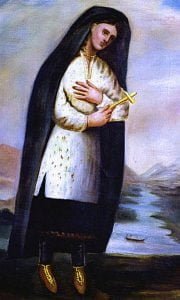
This Indian girl has been called, the Indian saint. She was born in 1656 at Candaouga, a Mohawk Village located on the south bank of the Mohawk River near where Auriesville now stands. Later she moved with her parents to Caughnawaga, a village of the Turtle Clan, located on the north side of the Mohawk River. Through the influence of three Jesuit priests, who visited her father, she learned of the Christian religion. On Easter Sunday, 1675, she was Baptized by Father LamberviIle. As a young woman she was skilled in doing work as Indian girls were accustomed to do at that period. She was good at moosehair and porcupine quill embroidery. She often made wampum belts used by the Mohawks in their ceremonies. She could sew well and her ribbon and bark sashes were well known. Though she was very frail it is said that she was very ambitious and a good worker. She was likewise very virtuous and led an absolutely pure life. Against her father’s will, this Indian girl was smuggled from her home by a Christian Mohawk named Ogenratatarihen. She was taken to Quebec to a Mohawk settlement near Montreal. She took a vow of chastity and thus became the first Indian nun among her people. She died April 17, 1650, and was buried south of the Lachine Rapids of the St. Lawrence River. Her entire life was one of purity and her remains in the Caughnawaga Church are said to have worked cures for those who believed in her. Both near the place of her birth along the Mohawk River and of her death along the St Lawrence River contain a monument erected to her memory.
Passing many an ancient Mohawk Village site the young warriors continued up the Great Central trail of the Iroquois and soon arrived at the City of Utica. Traveling to the southern end of the city they soon arrived at the Forest Hill Cemetery. There in a well kept plot they saw the sacred Oneida Tribal Stone.
